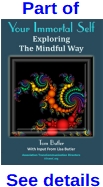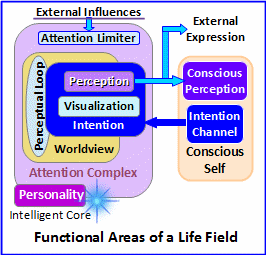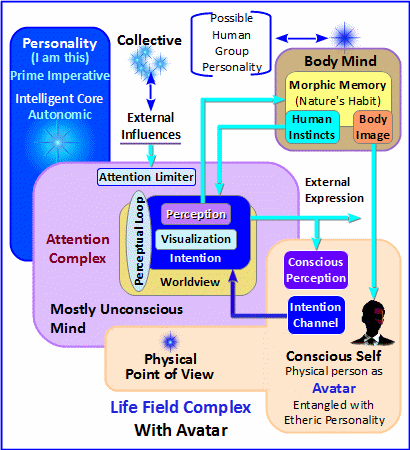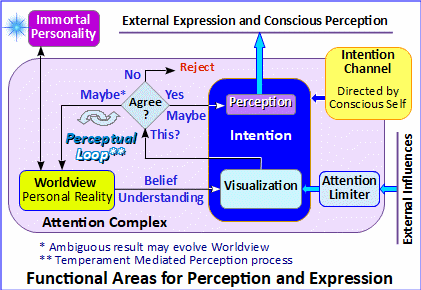Introduction to As A Man Thinketh by James Allen, 1902
 The objective of “This little volume” is “to stimulate men and women to the discovery and perception of the truth that they themselves are makers of themselves by virtue of the thoughts which they choose and encourage; that mind is the master weaver, both of the inner garment of character and the outer garment of circumstance, and that, as they may have hitherto woven in ignorance and pain they may now weave in enlightenment and happiness. James Allen
The objective of “This little volume” is “to stimulate men and women to the discovery and perception of the truth that they themselves are makers of themselves by virtue of the thoughts which they choose and encourage; that mind is the master weaver, both of the inner garment of character and the outer garment of circumstance, and that, as they may have hitherto woven in ignorance and pain they may now weave in enlightenment and happiness. James Allen
Introduction
How we think, how our worldview influences how we think and the relationship between who we really are as etheric beings and our physical body are related in the Implicit Cosmology as a complex of decisions called the Perceptual Loop. As noted in James Allen’s introduction to As a Man Thinketh, how we think is at the very foundation of who we are, because how we manage our thoughts determines who we might become. Much of our mind is normally out of reach of our conscious control, so this essay also addresses ways we might attempt to take control of the way our normally unconscious mind decides our fate.
This is all about the Mindful Way.
A Model of the Mind
The Implicit Cosmology is based on an engineer’s view of reality, so explanations you will read here are probably not ones you will learn from a psychologist. With that said, the model of mind needs to be explained in three parts:
- Life Field: A life field is modeled as the fundamental component of reality. It is further explained in the Life Field essay. The Functional areas of a life field are shown in the diagram at the right. The intelligent core of a life field is the functional areas called Personality.
- Avatar: A person is an immortal self entangled with a human in an avatar relationship. The conscious self of the personality experiences the physical during a lifetime from the perspective of the human. The functional areas of the avatar relationship are shown in the Life Field Complex Diagram below.
- Perception: Perception involves the interaction of Worldview and external influences and/or desired result with worldview in what is described as the Perceptual Loop. This is shown in the Functional Areas of Perception Diagram below.
Understand the Unconscious Processes
It is essential to understand the thought process if we hope to control it. Parapsychologist James Carpenter has developed a theory about how we mentally process information based on current understanding about psi phenomena. His hypothesis is detailed in the book, First Sight; ESP and parapsychology in Everyday Life. (1)
Review the Functional Areas of Perception Diagram below, and as I explain First Sight Theory, keep in mind that I am talking about how information you sense from the world around you is unconsciously compared to all of your existing beliefs, emotions and experiences before you even become aware that you have sensed something.
First Sight Theory
In his book, Carpenter explains that people first psychically sense the world. As he puts it: “What if ESP is like subliminal perception? What if psychokinesis is like unconsciously but psychologically meaningful expressive behaviors?” He answers these questions by proposing two propositions based on the assumption that:
Assumption: (paraphrasing) An important assumption of First Sight Theory is that everything and everyone, every action in the past, now or in the future, perturbs the subtle energy space that connects all of us. Carpenter argues that research indicates people psychically sense these changes in psi space just as they physically sense changes in physical space.
If that is True, then: (paraphrasing)
First, people sense their environment psychically as well as with their physical senses. Second, people process this information unconsciously, and it is the conclusion of that processing that they are aware of and react to … not what has been psychically or physically sensed or unconsciously considered. A person might psychically sense someone near or far, a person’s actions and apparently their thoughts when they are expressed as intention.
Note 1: The Intention Channel shown in the Functional Areas of Perception diagram represents the mechanism by which the conscious self is able to influence the perceptual process.
Note 2: In this theory, the expression of intention is what produces a change in psi space which can be sensed by others. Simply thinking of something does not appear to produce information which is detectable by others.
Note 3: The result of the unconscious perceptual process is described by Carpenter as formatting “experience and action.” This is the perception functional area in the Functional Areas of a Life Field diagram. In this context, the person does not directly experience information from the environment. Instead, the person becomes aware of the information after it is formatted in a way that agrees with worldview.
Therefore the following 13 corollaries address the perceptual process: (paraphrasing) (Italics text is more of an in other words explanation.)
-
The unconscious processes that constitute consciousness are personal and deliberate. (The more important it is to us, the more we unconsciously pay attention.) Personalness Corollary
-
Psi sensing is not limited by time or distance. Ubiquity Corollary Part 1
-
PK contributes to the formation of experience by bringing intention to bear upon the physical processes of the nervous system. (The first response to a meaningful stimulus is transmission of a telekinetic ‘alert signal’ to the body, and if useful, to the environment.) Ubiquity Corollary Part 2
-
Other preconscious processes are processed together with psi in a rapid, holistic, efficient, unconscious manner to format experience and action. Integration Corollary
-
The importance of sensory and extrasensory information is weighted as being more or less important before it is acted upon. (The yardstick for importance is based on the body’s survival instincts and cultural conditioning stored in worldview.) Weighting and Signing Corollary
-
The content of conscious experience, emotional states and behavioral choices are constituted in a summative way by unconscious thought. Summation Corollary
-
In this summative process, the person may turn toward information (signed positively) to include it in the construction of experience, affect or action, or turn away from information (signed negatively) and exclude it. Bidirectionality Corollary
-
Including or excluding information is a function of unconscious intention in regard to an element of potential meaning. (While attention is the result of an “is this important to me” decision, information that results in action by the person is given force if there is an intention to act.) Intentionality Corollary
-
A person will be fairly consistent in how information is processed, (but) may switch in how information is weighted, the sign attributed to it, and therefore, whether or not it is included in behavior. This switching will occur rapidly or slowly depending on the consistency and purity (focus) of unconscious intention, and this, in turn, is determined by the relative weight of the information over time, situational factors that promote or diminish critical analysis, changes of approach in a task and mood. Switching Corollary
Switching, which is influenced by personality style, is not necessarily a good thing.
Persons who are disposed to switch rapidly include those who:
-
- tend to approach situations cognitively and analytically
- lack consistent purpose and motivation
- take a detached-observer posture toward most situations
- are chronically ambivalent
- are cognitively disorganized are highly distractible
Persons who tend to switch slowly, conversely, tend to be persons who:
-
- approach situations globally and holistically
- are strongly and consistently purposive
- engage themselves wholeheartedly in situations
- are not overly self-doubting or uncertain
- are well-integrated cognitively
- are prone to hold focus purposively and not become distracted
- are dissociative (when in certain states).
Note 4: Highly dissociative people often experience altered ways of being that are more complex and enduring than simple moods.
-
The frequency of switching affects the relative density of accumulated additive or subtractive references to the meaning in question. Rapid switching renders potential meaning irrelevant to ongoing experience. Extremity Corollary
-
Information gathered via psi is not available to conscious experience but does contribute to the formation of conscious experience by the arousal of anticipatory networks of ideas and feelings (assuming that they are heavily weighted, afforded slow switching and approached with the intention of assimilation). Because of this arousal, their action can be glimpsed consciously only by observing thoughts, feelings and behaviors that are inadvertent; that is, not intentional and not obviously caused by any current experiences. Someone who has become skillful in interpreting them is thought of as relatively psychic. Inadvertency and Frustration Corollary
-
The arousal of anticipatory networks of ideas and feelings resulting from unconscious psi information may be considered liminal ones, in terms of the boundary between conscious and unconscious thought. Habitual interest in liminal experiences facilitates expression of psi processes (openness), leading to unconscious reference to psi material (and other streams of unconscious material). A more positive, open, secure state of mind will tend to facilitate reference to a broader spectrum of contextual, potentially liminal experience. (In other words, habitually paying attention to subtle information emerging from your unconscious can lead to more direct awareness of what has been psychically sensed from psi space.) Liminality Corollary
The Perceptual Process
The functional areas of perception are discussed in detail in the Creative Process essay.
The Functional Areas of Perception Diagram shows how the Attention Complex (unconscious mind, large violet rectangle) translates external inputs into conscious perception which potentially results in an external expression. The external input is assumed to be either a psi source or a physical source which is preceded by a psi precursor to that input.
The worldview functional area is like a database representing memory, understanding and beliefs. The perceptual process constitutes an attempt to visualize the meaning of an external input based on the best match of content already present in the worldview database. If the “Agree?” decision is negative, the process may be repeated many times in quick succession, depending on the perception of urgency.
The parameters of the perceptual process—how the information is processed—are described by First Sight Theory explained above.
According to James Carpenter, people are not aware of environmental inputs until they have unconsciously made a decision about them. From the Implicit Cosmology perspective, if the input does not agree with Worldview, it will probably be ignored. This is a very real form of blindness sometimes referred to as inattentional blindness. This behavior might be referred to as incredulity blindness when referring to beliefs.
If the result of the visualization process is close to something that is in worldview, or is indeterminate, the ambiguous visualization might be incorporated into worldview. In this way, it is thought that worldview is evolved.
Implications of First Sight Theory
External stimuli are always psi-related. If the input is physical, then it is assumed to be accompanied, or even preceded, by some kind of psi signature perturbing psi space. This perturbation is psychically sensed by the organism as an unconscious stimulus which may or may not be consciously sensed, depending on the result of the perceptual process.
To illustrate, a person might psychically sense a developing threat before it becomes physically obvious. The perceptual process would give meaning to that threat based on past conditioning and the person would react, at first unconsciously with a slight tension of muscles and possibly increased adrenaline; however, if the threat manifests to the person’s physical sensing, this unconscious preparation for the fight or flight response would be followed by conscious action.
The idea of turning toward or turning away from information during the perceptual process evokes a good sense of what happens in our mind. For instance, if you instinctively dislike a person or situation, it may be that you have unconsciously psychically sensed something and your Perceptual Loop has sent a “this is not for you” response to your conscious awareness.
In that way, we are naturally psychic because we are able to consciously sense the result of the perceptual process—not as a direct sensing of the psi influence, but as the conclusion that process has sent to your conscious mind. However, according to First Sight theory, you can train yourself to be more directly aware of that initial psi sensing by learning to encourage your conscious mind to pay attention to those subtle messages that seem to emerge from the back of your mind.
Changing Worldview
There is much research indicating that people who are open to more directly sensing psi stimuli have more psi-related experiences, while people who are not can be literally blind to the phenomena. In both cases, people psychically sense the same information, but that sensing is not as easily translated into conscious awareness for nonbelievers.
As such, James Carpenter suggests that a person wishing to be more psychic should maintain an open, non-analytical frame of mind while also maintaining a commitment to the goal of psi expression. Analysis of information, self-criticism and doubt tends to cloud psi awareness.
Translate “open mind” as “suspended judgment.” Make a habit of not deciding whether or not you believe something. Instead, maintain a wait and see attitude. Consciously suspending judgment has at least an indirect effect on the perceptual process, which should in turn, exaggerate the ambiguity of the comparison between what is being visualized based on worldview to produce a beneficial change in worldview.
The Mind is Etheric
Everything in the Functional Areas of a Life Field Diagram is nonphysical. That is, it is not in the physical space as occupied by your physical body, instead, it is in the greater reality of psi space, of which the physical universe is just a part. The physical brain is best viewed as a transmitter/receiver for thought and the interface between your immortal I Am This personality and your physical consciousness I think I am this. How aware your conscious self is of your etheric personality is referred to as lucidity and the objective of personal development is to become as lucid as possible. That, in turn, is accomplished by aligning worldview with the actual nature of reality.
Becoming psychic is not the end objective of personal development, but it is a means of gaining lucidity. Psi sensing is a normal but indirect way of sensing the world. Being psychic is learning to understand how that unconscious sensing is translated by the mind into physical awareness. Suspended judgment is one technique. Another is mindful living; make a habit of thinking of the consequences of your actions. I refer to that as the Mindful Way.
Hyperlucidity
This psychogenic disorder is marked by the tendency to find phenomena everywhere despite considerable testimony to the contrary by peers. The concept comes from occasional reports of odd behavior exhibited by some people when they visit an emotionally charged and is known by such names as Paris syndrome and Jerusalem syndrome. In regard to paranormal phenomena, the effect is the experiencer’s mistaken belief in experiencing paranormal phenomena such as reporting voices in recordings when there are none, seeing features in featureless visual media and misattributing thoughts as transcommunication.
This is a difficult concept because there may be a tendency to use it as an argument against the existence of transcommunication. Instead, hyperlucidity should be looked at as an enthusiastic approach to the study of things paranormal that is not balanced by education about the subject and the necessary discernment to see things as they are. As a characteristic, it eventually moderates as the person become better informed.
Inspirational writer, William Arthur Ward, told us that, “If you can imagine it, you can achieve it. If you can dream it, you can become it.” That empowering advice pretty much sums up the point of view taught to people studying psi phenomena. Imagining something is true gives the mind a kind of permission to look beyond old beliefs engrained in worldview. This is an effective tool for personal development; however, a distinction must be made between thinking one can do what is visualized and believing one has done what is visualized even though that is not the case. This is one of the reasons peer monitoring is so important. See: Witness Panel
It is discussed in the Creative Process essay that informed visualization is followed by expression. That is to say, the work must be done to embody the imagined outcome. So, the key to understanding hyperlucidity is to look for hints of magical thinking. If a person thinks ability comes upon them as if as a gift, rather than by way of study and practice, then an observer should first look for the objective evidence. If that is available, the next question concerns the validity of that evidence. Can it be independently experienced?
Perception is First an Unconscious Process
This is a fine point that is too easily missed. All of mind is etheric and all of the perceptual process is normally unconscious. That is, all of the functions represented in the Attention Complex are normally unconscious.
The inflow of sensed environmental information is a streaming process so that an event is sensed in essentially instantaneous bits as it occurs. The Perceptual Loop also reacts to this incoming information and attempts to develop an image of what it is, based on the information and worldview. A person may become conscious of the event as it is occurring, but only in the form produced by the Perceptual Loop.
Assuming it passes the Attention Limiter, if the Perceptual loop does not indicate recognition of the information, it may be rejected (ignored), modified by worldview to something that is recognized or it might modify worldview as it is perceived. This is the process for perceptual agreement.
As the event unfolds, the image developed in the perception process evolves into a story and the person may become aware of that story as it unfolds … and continues to change to more agree with the incoming information.
In dreams, the separation between story formation and dream consciousness (whatever that is) is apparently much smaller, resulting in stream of consciousness dreams that seldom make sense beyond the moment.
An exchange of information between life fields will be in the form of a thoughtform which represents a gestalt packet of intended information. This, in turn, will be filtered based on perceptual agreement and passed to the conscious self as a sense of understanding, which is also a gestalt perception.
So as modeled in the Implicit Cosmology, the modes of perception are:
- Instantaneous sample (unconscious)
- Streaming perception (unconscious)
- Streaming story (conscious)
- Gestalt (unconscious)
- Sense of understanding (Conscious gestalt)
Interesting Speculation
In the hypothesis of Formative Causation, Rupert Sheldrake (2) proposes that the formation of an organism is organized by fields of etheric energy which are nested so that the simplest organic chemical process is managed by a field, which is in turn organized into more complex organisms by greater fields, and so on to the top field of, say a human or a tree. There is good reason to believe that the etheric personality is the organizing field for the avatar physical body, and is in turn, part of a collective of other personalities which eventually brings us, in the hierarchy of life, to a source.
In this view, one might think that there is life and there is the product of life. That is, the Functional Areas of a Life Field Diagram needs only a slight modification to be a depiction of the creative process, and as such, might be used as a model for life. Each organism, be it a single-cell amoeba or a human, involves this creative process to one degree or another. (Life fractals: Qualitatively the same but quantitatively different)
Objects of reality, such as a rock or a cup of water, are expressions of life. We see a primitive demonstration of this during some séances in which the etheric controls work through a physical medium to produce increasingly solid ideoplastic structures such as the ectoplasmic rods employed to suspend a trumpet or point of luminosity.
Reference
-
Carpenter, James, C. First Sight: ESP and Parapsychology in Everyday Life. s.l. : Rowman & Littlefield Publishers, 2012. ISBN 978-1-4422-1392-0 (ebook).
-
Sheldrake, Rupert PhD. Morphic Resonance and Morphic Fields. Rupert Sheldrake Biologist and Author. sheldrake.org/Articles&Papers/papers/morphic/morphic_intro.html .
![]()


